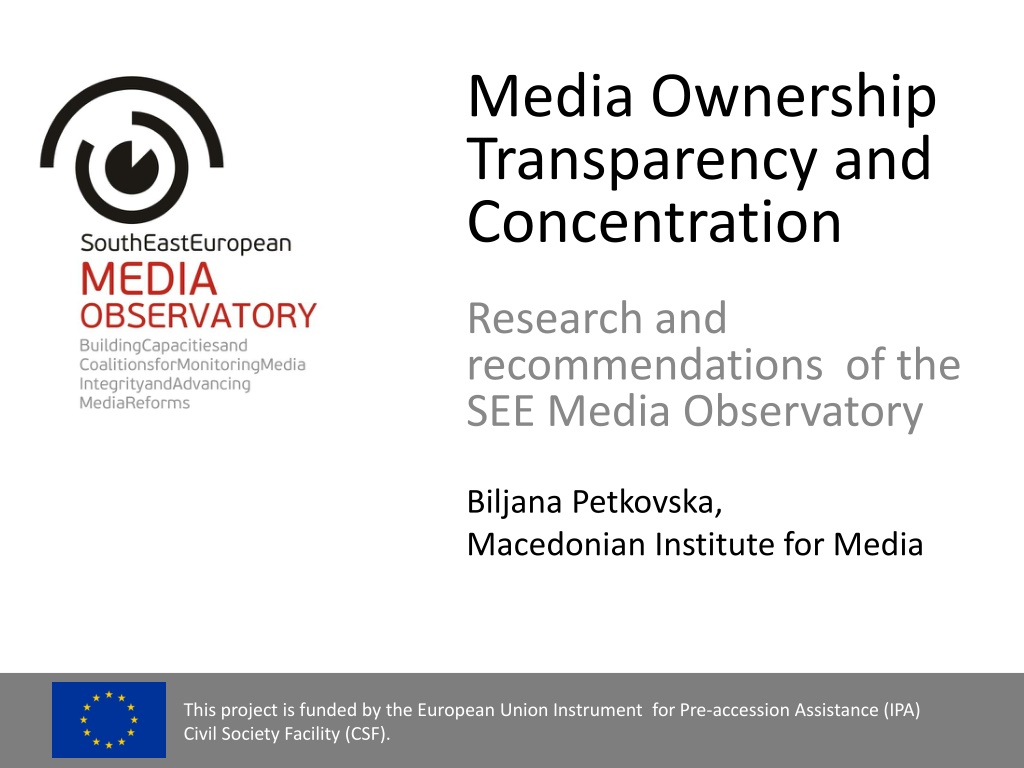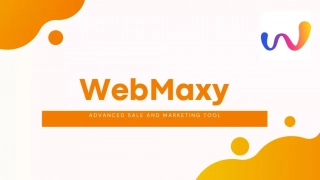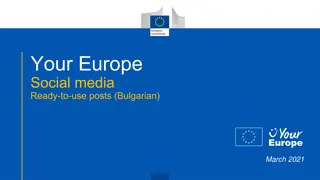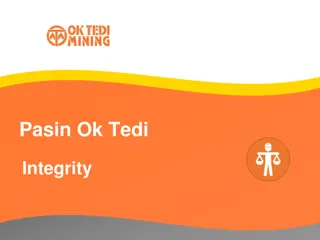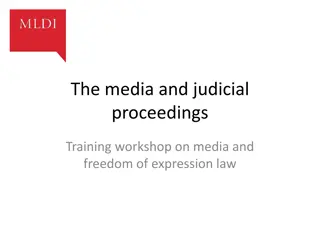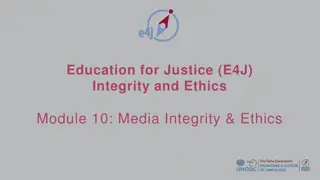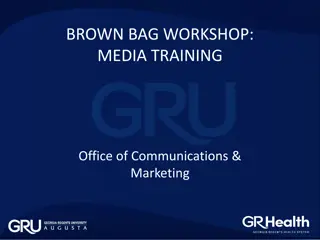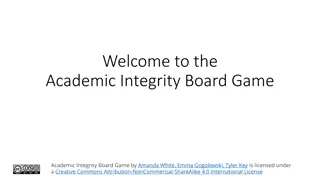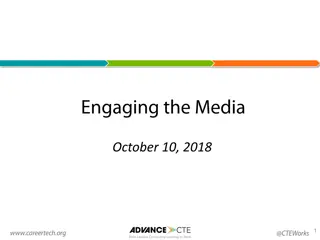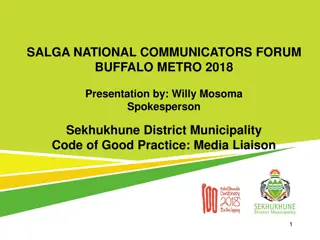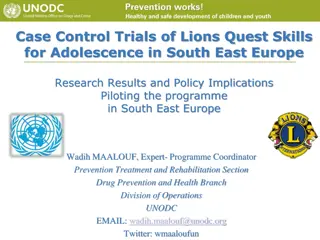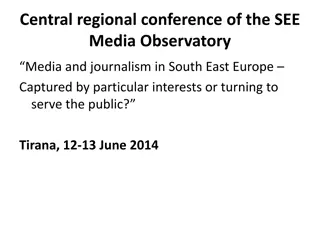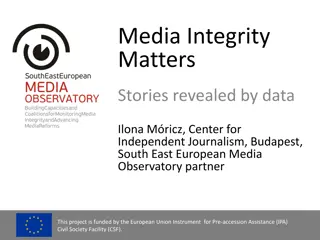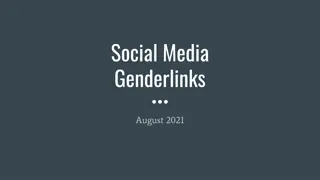Enhancing Media Integrity in South East Europe
South East European Media Observatory focuses on media ownership transparency, concentration, and integrity in the region. Through research, reports, and grants, it aims to promote media freedom, pluralism, and ethical journalism. The Observatory identifies risks to media integrity across various areas such as media policy development, structures, journalist status, and practices. By advocating for changes and fostering dialogue among key actors, the Observatory plays a crucial role in shaping media reform processes at a national and regional level.
Download Presentation

Please find below an Image/Link to download the presentation.
The content on the website is provided AS IS for your information and personal use only. It may not be sold, licensed, or shared on other websites without obtaining consent from the author. Download presentation by click this link. If you encounter any issues during the download, it is possible that the publisher has removed the file from their server.
E N D
Presentation Transcript
Media Ownership Transparency and Concentration Research and recommendations of the SEE Media Observatory Biljana Petkovska, Macedonian Institute for Media This project is funded by the European Union Instrument for Pre-accession Assistance (IPA) Civil Society Facility (CSF).
South East European Media Observatory? is a regional partnership of civil society organizations aimed at enhancing media freedom and pluralism, and influencing media reforms in the countries of South East Europe. connects seven media centers/institutes from Albania, Bosnia and Herzegovina, Croatia, Hungary, Macedonia, Serbia and Slovenia (led by Peace Institute, Ljubljana) started in December 2012 with the support of the European Union Phase 1: two years, until December 2014 Phase 2: 2015-2016 to include also Kosovo, Montenegro and Turkey
SEE Media Observatory a regional instrument to monitor and research media integrity on regular basis, based on common methodology, producing national reports and regional overviews, and informing reform processes on national and regional level provides also support (grants) to investigative journalists to investigate and report on corrupt practices and relations in the media system, and support (grants) to other CSOs to advocate for changes provides national and regional frameworks for exchange and dialogue between key actors Web site: http://mediaobservatory.net/
Media integrity? SEE Media Observatory has adapted a concept media integrity to denote public service values in media and journalism has elaborated definition of media integrity and identified more than 60 risks for media integrity if 4 risk areas: 1) media policy development and implementation; 2) media structures (ownership, finances and public service broadcasting) 3) journalists (their status and situation), and 4) journalistic and media practices.
Media integrity: definition Media integrity encompasses qualities of the media system policies, structures and practices in the media field, and their relations which enable the media to serve public interest and democratic processes, demonstrating in their operations and content: freedom and independence from particular/special private or governmental interests, transparency of own operations and interests including clear disclosure of exposure to or dependence upon particular private or governmental interests, commitment to and respect for ethical and professional standards, and responsibility and responsiveness to citizens.
Media integrity: definition Media integrity more specifically refers to: ability of the media to provide accurate and reliable information to citizens without dependence upon, serving of and clientelistic relations with particular/special private or governmental sources, as well as to provide citizens with access to and expression of wide range of views and opinions without exposure to bias and propaganda.
Media integrity: definition Media integrity also integrates: capacities of journalists and other media professionals to apply professional autonomy and standards, demonstrating commitment to serve public interest against relations and practices which corrupt and instrumentalize the profession for particular/special private or governmental interests. Such journalistic capacities include transparency of dependence upon particular interests and sources, and commitment of journalists to protect professional standards in such circumstances.
Media integrity vs. institutional corruption in the media system Media integrity relates to the notions of media freedom and independence, as well as to media pluralism, but within attempt to capture causes for and manifestations of dysfuncional democratic role of the media in South East Europe it tends to develop additional analytical category focusing on institutional corruptionin the media system, on manifestations of economy of influenceand conflicting dependence(Lessig, 2010) in the media sector
Media integrity research conducted between July 2013 and February 2014 focused on mapping patterns of corrupt relations and practices in media policy development, media ownership and financing, public service broadcasting, and journalism as a profession Five countries covered by the research: Albania, Bosnia and Herzegovina, Croatia, Macedonia and Serbia (Croatia was still a candidate country for EU when we started the project in December 2012) Published in the book Media Integrity Matters Reclaiming Public Service Values in Media and Journalism , June 2014; presented at the regional conference in Tirana.
Media integrity research media integrity research and the book Media Integrity Matters build on the legacy of previous research and advocacy actions of the regional network SEENPM, especially the 2003/2004 research and book on media ownership and its impact on media independence and pluralism in fact, the present media integrity research has been an elaboration of the situation ten years after (2013/2014)
Key findings (regional): Transparency of media ownership Transparency of ownership is limited Lack of proactive stance in providing the information Lack of central and easily accessible sources of information (BiH) Provided information are incomplete (Croatia) Lack of control of the origin of the capital Possibility of hidden ownership through off-shore companies (Cyprus, Russia, Austria) Ownership especially vague in online media sector
Key findings (regional): Concentration of media ownership concentration of ownership evident in some of the countries in the region (Croatia, Albania) trend of strengtening larger media groups (Albania) ownership concentration remains an open threat due to the lack of regulation of media concentration (BiH)
Regulation of media ownership: De jure Rules (de jure) Albania BiH Croatia Macedonia Serbia Transparency rules for all media Partially (no verification) Partially (too general rules) Yes Partially Partially (rules are minimal) Anti- concentration rules Yes No Yes Yes Partially (only AV) Cross-ownership rules Partially (print-AV allowed) No Yes Yes Partially (limited rules)
Regulation of media ownership: De facto Though transparency rules are in place, there are strong indications of hidden ownership (Albania, BiH, Macedonia, Serbia). Though public registers on media exist, the data are hard to get (BiH, Croatia), and/or there are no mechanisms to check/verify those data (Serbia). Though anti-concentration rules are in place, there is evidence of concentration in the media market (Albania, Croatia)
Mechanisms of evading rules: Transfer of ownership within family as mechanism for surpassing anti-concentration rules or conflict-of-interest rules (Albania, BiH) A foreign company registers as local enterprises and surpasses barriers on foreign ownership (BiH) or anti-concentration rules (Serbia).
Other common problems There is least transparency of online media (Albania, BiH), since they are often not registered as media outlets. General anti-monopoly body is in charge of media as well, but no specific rules pertain for media and the bodies rarely intervene in media sector.
Key findings: media ownership (country by country) Albania: Despite formal transparency of ownership of media outlets, concerns about hidden owners and shares remained. Ownership of online media is least known. Poorly implemented regulation. BiH: Media ownership in B&H is largely unregulated, with loopholes allowing true owners and origin of the capital to remain hidden. Ownership transparency of online media is particularly vague.
Key findings: media ownership (country by country) Croatia: Public registers do not reveal persons behind companies that own media. Despite anti- concentration rules, two companies (EPH and Styria) hold 90% of print media market, obtained through obscure privatisation processes.
Key findings: media ownership (country by country) Macedonia: Domination of local media moguls (predominantly in television sector) who perfected the methods of (mis)using their media in order to achieve their political and business interests. Media owners switch their political allegiances depending on who is in power. New legislation (end of 2013/amended January 2014) requires also from the owners of print media to disclose their media stakes. However, many media have formal owners, and real owners behind the scene.
Key findings: media ownership (country by country) Serbia: Inadequate regulation prevents effective control of illicit market concentration and enables media owners to remain hidden for years. It also enables legalization of shady capital through the media and infiltration of business oligarchs and politicians in the media in a non- transparent way.
Recommendations: Albania Develop legislation concerning ownership concentration of the print and online media. Reconsider cross-ownership rules, given the tendencies towards concentration of the media market. Increase monitoring of dubious practices in ownership patterns: involve Competition Authority along regulatory body ensure that controversial or hidden cases of ownership are investigated.
Recommendations: BiH Enhance transparency of official data on media ownership: put online court registers of business entities in RS online registers should be centralised or mutually linked the CRA online register of broadcasters should include information on media owners Develop mechanisms to track hidden ownership: state authorities to investigate possible controversial, hidden ownerships legislation should be enhanced in order to prevent indirect foreign ownership that was identified in few major cases Adopt legislation preventing the concentration of ownership in cooperation with the Council of Competition, CRA, Ministry of Communication and other relevant institutions.
Recommendations: Croatia The existing online database (provided by the regulator) of media outlets ownership structure should be clear and consistent, given in user- friendly interface. Further limits on media concentration (both vertical and horizontal) should be introduced. News media should be granted specific status, which would disable broadening of ownership to the non-media-related fields.
Recommendations: Macedonia Online media should be part of self-regulatory system and thus should publish data on their ownership and sources of funding on their websites. The Press Council should expand Code of Ethics in order to encompass the issue of media transparency in the online media sector as well. NGO should establish independent monitoring system in order to track and publish ownership data in all media sectors. The audiovisual regulator: should be legally obliged to investigate the hidden connections between the AV media and politicians. should publish (aqt least 4 times a year) brief media ownership reports and the information from the Central Registry Database system on all companies/individuals connected with AV media outlets.
Recommendations: Serbia The Ministry of Culture and Information should provide clear by-laws for privatization of the remaining state media. Journalists should be assisted to become media owners by reduced taxes for media enterprises in their ownership for three years after privatization. The Commission for Protection of Competition should make a study of concentration trends in the media market on the national and regional level as soon as possible. The Ministry of Culture and Information should create a database on all relevant aspects of the media industry, that are currently unknown
Conclusion: Why media policy in the field of media ownership and on generally failed to protect the public interest? Westernization copy-paste media laws Legislation harmonized with the EU standards but implementation very weak Policy objectives that clashed with reality Policies without strategies and consensus Policies guided by political and business interests Civil sector weak or with little influence Regulators under political pressures This project is funded by the European Union Instrument for Pre-accession Assistance (IPA) Civil Society Facility (CSF).
